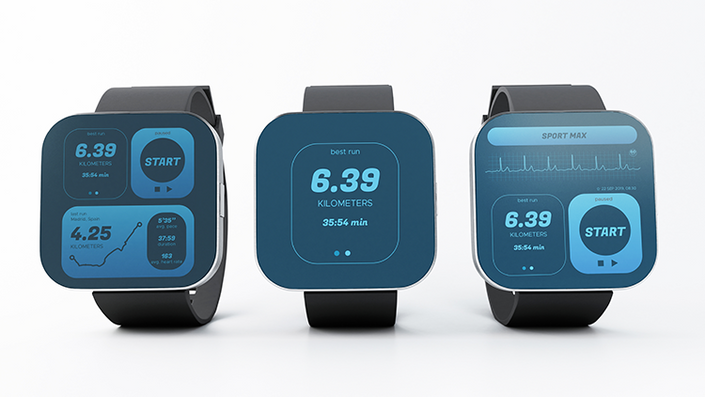Since its early release, smartwatches have seen significant development, going from specialized devices to necessary accessories that combine fashion and technology. The swift progression of technology and the demands of consumers have propelled this metamorphosis. We’ll examine the history of smartwatches in this blog, emphasizing significant inventions and turning points that have influenced the technology’s advancement while also projecting potential future developments.

1. The Early Days: Basic Functionality and Limited Appeal
a. The Birth of Smartwatches
- 1990s Beginnings: The concept of smartwatches dates back to the early 1990s. Early models like the Seiko Ruputer and IBM WatchPad were rudimentary, offering basic functions such as timekeeping and simple notifications. These early devices were often bulky and had limited functionality, primarily serving as a novelty rather than a practical tool.
b. Initial Challenges
- Limited Technology: Early smartwatches struggled with limited processing power, short battery life, and small display screens. The technology of the time constrained their capabilities, making them less appealing to the general public.
2. The Rise of Modern Smartwatches: Integration and Innovation
a. The Advent of Touchscreens
- 2000s Developments: The 2000s saw significant advancements with the introduction of touchscreen technology. The introduction of devices like the Samsung SPH-WP10 and the Microsoft Smartwatch paved the way for more interactive and user-friendly experiences. These watches featured color screens and improved interfaces, making them more practical for everyday use.
b. The Impact of Smartphones
- 2010s Breakthroughs: The rise of smartphones in the early 2010s played a crucial role in the development of smartwatches. Companies began to focus on creating devices that complemented smartphones, integrating features such as notifications, fitness tracking, and voice commands. The launch of the Pebble Smartwatch in 2013 marked a significant milestone, being one of the first successful smartwatches to offer app integration and customizable watch faces.
3. Mainstream Adoption: Advanced Features and Ecosystem Integration
a. The Apple Watch Era
- 2015 Onwards: The release of the Apple Watch in 2015 was a game-changer for the smartwatch industry. With its sleek design, advanced health monitoring features, and seamless integration with the iPhone, the Apple Watch set a new standard for wearable technology. Features such as heart rate monitoring, GPS, and third-party app support became more prevalent.
b. Expanding Capabilities
- Health and Fitness: As smartwatches gained traction, health and fitness features became a major focus. Devices began to include sensors for tracking various health metrics, such as blood oxygen levels, ECG readings, and sleep patterns. Companies like Fitbit and Garmin also emerged as key players, offering specialized smartwatches with advanced fitness tracking capabilities.
c. Smartwatch Ecosystem Integration
- Cross-Platform Functionality: Smartwatches began to integrate with various ecosystems, offering compatibility with both iOS and Android platforms. This era saw the development of Wear OS by Google and the expansion of smartwatches compatible with both major mobile operating systems. This flexibility allowed users to choose a smartwatch that best suited their existing devices.
4. The Present and Future: Cutting-Edge Technology and Emerging Trends
a. Advanced Health Monitoring
- 2020s Innovations: Modern smartwatches are pushing the boundaries of health monitoring with advanced features like ECG and blood glucose monitoring. The Apple Watch Series 7 and Fitbit Sense, for example, offer comprehensive health insights and alerts for potential medical conditions.
b. Integration with AI and Smart Home Technology
- Smart Ecosystems: The integration of artificial intelligence (AI) and smart home technology is becoming more prevalent. Smartwatches can now control smart home devices, interact with voice assistants like Amazon Alexa and Google Assistant, and provide context-aware notifications based on user behavior and preferences.
c. Design and Customization
- Stylish and Functional: Modern smartwatches combine style with functionality, offering customizable watch faces, interchangeable bands, and sleek designs. Brands are focusing on aesthetics as well as performance to appeal to a broader audience.
d. Future Prospects
- Emerging Trends: Looking ahead, smartwatches are expected to continue evolving with advancements in battery technology, more accurate health sensors, and enhanced connectivity features. Innovations such as augmented reality (AR) and improved integration with other wearable devices may also shape the future of smartwatches.
Conclusion
Constant innovation and adaption to shifting consumer demands and technological advancements have characterized the evolution of smartwatches. Over the years, smartwatches have seen tremendous changes, evolving from simple devices to powerful multifunctional gadgets. The future of smartwatches promises to be even more exciting as technology develops, fusing cutting-edge functionality with fashionable designs to improve our everyday lives.
Wearables enthusiasts, fitness fanatics, and those just searching for an easy way to stay connected can all benefit from smartwatches, which provide a window into the future of wearable technology. It’s obvious that smartwatches will continue to have a significant impact on how we use technology and take care of our health and wellbeing as time goes on.
